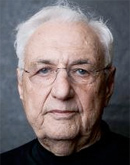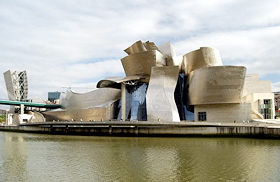
Frank Gehry will celebrate his eightieth birthday
 |
"I try to design buildings as a response to human feelings," explains the guru of world architecture, whose buildings are tourist attractions everywhere. For inspiration, he cites sources as diverse as Indian sculptures of the god Shiva or his grandmother's stuffed carp before it was prepared in the kitchen.
Gehry's signature is also present in Prague's Dancing House on Rašínova nábřeží, where the architects were loosely inspired by the facades of surrounding buildings, mostly art nouveau and with turrets. "It occurred to us that we would also add towers to our building and make one glass. But the glass tower would obstruct the view from the windows of the neighboring houses, so we narrowed it in the middle until it began to resemble a female figure and the whole building became a dancing couple," Gehry described in 1997.
Another remarkable object by Gehry from recent times is the Walt Disney Concert Hall in Los Angeles, which now towers in the city center like a gigantic iron flower, exposing its bare metal beams, bolts, and pipes, as well as stone stairs and light wood. After its opening in October 2003, it became a symbol of a new America, even though during the decision-making process for its construction, a certain politician expressed indignation with the words: "We can't have a concert hall slapped together from wire fences, plywood, and corrugated fencing!"
A strangely shaped gelatin cake, which has outgrown the pastry chef's mold, again resembles Gehry's house in American Seattle: with blue, red, silver, and shiny walls that wave like curtains in the wind and don't recognize a right angle. In one place, the building opens up to allow the local monorail to pass through. The house is called the Experience Music Project, and with a total of 250 million dollars, it was contributed to by Bill Gates.
 |
But even before the houses made Frank Gehry famous, he gained recognition for his paper designs. In his former work for department stores, he was tasked with designing furniture for windows that nobody would really sit on. He solved this brilliantly: he utilized waste, corrugated cardboard that goods are packed in for industrial use. Upon its market release, his furniture became a hit and is still taught to design students today. He ended the epidemic of cardboard ideas with the legendary Little Beaver chair in the 1980s.
The humble and witty American of Polish descent, Gehry grew up in Canada during the crisis of the 1930s. Born on February 28, 1929, as Ephraim Owen Goldberg, he explored the insides of broken toasters and clocks at his grandfather's hardware store in Toronto, building fairy-tale cities from spare parts. His father's businesses were failing, so they set out for Los Angeles. There, Gehry installed prefabricated dining corners in homes during the day and studied architecture at the University of Southern California in the evenings.
In the late 1970s, he first renovated his simple house in Santa Monica. He used wire fencing, corrugated metal, and bare wooden beams for it. The house repelled his neighbors, and they hated the construction - one of them let their dog relieve itself on it. "It wasn't a provocation, I simply had too little money for the renovation," Gehry insisted. "Then I thought that it was aesthetically interesting. So why not turn low costs into an advantage?"
A former passionate hockey player and admirer of Jaromír Jágr named his chairs things like Cross-Check, High Stick, or Power Play. It is said that he hires novice collaborators for his firm based on their relationship to this sport. In 2003, he even tried his hand at being a set designer, with his first task being the American premiere of Leoš Janáček's opera Fate.
The English translation is powered by AI tool. Switch to Czech to view the original text source.
1 comment
add comment
Subject
Author
Date
e.m.p. v Seattle
Petr Šmídek
26.02.09 03:02
show all comments











